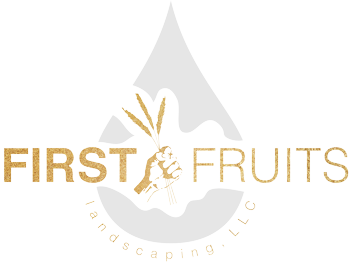Now is a great time to consider lawn renovation. The spring weather is perfect for regrowing a lawn or restoring it to its former glory. Perhaps it’s been overrun with weeds and you’re struggling to keep up with it. If you’d like to scrap it all and do over, May and June’s rain plus the sun makes this time perfect for lawn renovation. April, May, or September are great times to consider renovating your lawn. And there are several different ways to do this. A simple renovation could mean just over seating a small patch of lawn. A little more intricate could mean including power raking and core aeration if the soil is compacted and thatch is built up greater than 1/2 inch. A complete lawn renovation is removing all the undesirable grass with a nonselective herbicide and beginning fresh.
Here are three easy steps to lawn renovation and how First Fruits Landscaping offers lawn restoration and renovation.
#1. Thatching.
Now is the time to thatch the yard. We will want to rake the lawn area firmly to remove excess debris. Thatching or dethatching is the process of taking all of the clumps together with dead organic matter and removing it from the lawn. Over time, dried grass, leaves, and any dead organic material can get trapped between the blades of grass making it almost impossible for new grass to grow. We first renovate the lawn by getting rid of any weeds, pests, and creating a beautiful blank canvas for new grass to grow.
Aerating the lawn also comes with thatching and this can be done either with lawn equipment or by hand. We will remove all undesirable vegetation including moss, thatch, weeds and any pests. We can fix the low spots if they are revealed during the thatching process as well. Once thatching is done we can move on to top dressing.
#2. Top dressing.
Top dressing is a sand or prepared soil mix applied to the surface of the lawn. They are evenly applied in a thin layer of about 1/4 of an inch. This top dressing is used to smooth the surface of the lawn and it can reduce thatch buildup by encouraging decomposition.
Top dressing should be done in either late spring or early summer with a sandy loam of no more than 10 mm. The tips of grass if any is left should still be visible after top dressing. If needed, we will add in compost or other soil amendments depending on the pH balance of your soil. The top dressing can be worked down into the thatch layer by raking, washing it in with rain or sprinklers and allowing it to settle on its own. This may be a labor-intensive activity but it is necessary for lawn renovation.
The benefits of top dressing are numerous and it’s the foundation for every lawn care program. Top dressing can improve soil biology by adding organic matter and social structure and drainage can be modified by top dressing with sand or other corrective materials.
#3. Overseeding.
Once thatching and top dressing is complete you want to seed the area. The method of overseeding simply means planting grassy directly into existing turf without tearing up the grass. It’s an easy way to fill in bare spots, improve the density of the turf, and established improve grass varieties to enhance your lawn. Lawn renovation doesn’t necessarily mean you have to pull everything up and start from the ground so once thatching and top dressing are complete, overseeding right over the existing healthy lawn is a great way to bring back the vibrance and lush quality of your yard.
If we’ve completed a moss control treatment will want to wait a couple of weeks before adding in the seed. Any bare soil surface should be lightly roughed up for the seed to make good contact. Overseeding with a quality brand of Northwest-grown seed depending on the type of shade or sun the lawn gets will require 7 to 10 pounds of seed per 1000 ft.² area.
How to Care for a Newly Seeded Lawn
If you’re ready to restore your lawn give us a call for a quote today. We come out and analyze the current lawn condition and offer lawn renovation suggestions to restore your lawn to its lush, and beautiful place to entertain and enjoy.

